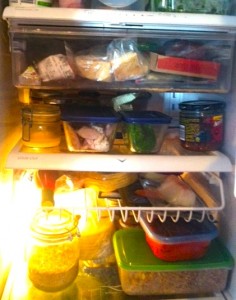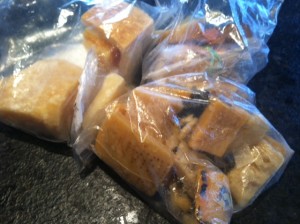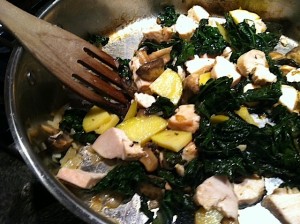 This is the inside of my refrigerator. I admit I’ve got some serious hoarder tendencies, especially when it comes to food. While I’m not especially proud of my mismatched assortment of Pyrex and Tupperware, I have to say that opening the door and seeing those myriad containers of leftover food makes me feel good. First, it’s fun for me to plan meals using leftovers, and I know making those meals will be quicker and easier than starting from scratch. And second, I like the idea that I’m not contributing (or at least not very much) to the huge problem of food waste we have in this country.
This is the inside of my refrigerator. I admit I’ve got some serious hoarder tendencies, especially when it comes to food. While I’m not especially proud of my mismatched assortment of Pyrex and Tupperware, I have to say that opening the door and seeing those myriad containers of leftover food makes me feel good. First, it’s fun for me to plan meals using leftovers, and I know making those meals will be quicker and easier than starting from scratch. And second, I like the idea that I’m not contributing (or at least not very much) to the huge problem of food waste we have in this country.
It shocked me to learn recently that 40% of the U.S. food supply ends up in the trash. That’s about $165 billion worth of food. This is a real problem that affects the environment, public health, and the economy. The same paper explains that if we could reduce food waste by just 15%, in a year we could feed 25 million hungry Americans — and save over $2,000 per family.
(Which makes me feel better about my collection of cheese rinds.)
 I realize that the bulk of the inefficiencies and issues around food waste are beyond our personal control. If you’ve ever been to a food bank warehouse, you’ve seen the vast amounts of perfectly edible food that is rejected by grocery stores. Often, there is so much that the aid agency can’t even distribute it fast enough and it ends up rotting. I once saw rows and rows of pallets piled high with butternut squash — enough to feed a small city — that had been deemed unsightly by a grocery distributor. No one had any idea what to do with all of it. Even though it looked beautiful to me and was just begging to be roasted and pureed, it was about to be tossed.
I realize that the bulk of the inefficiencies and issues around food waste are beyond our personal control. If you’ve ever been to a food bank warehouse, you’ve seen the vast amounts of perfectly edible food that is rejected by grocery stores. Often, there is so much that the aid agency can’t even distribute it fast enough and it ends up rotting. I once saw rows and rows of pallets piled high with butternut squash — enough to feed a small city — that had been deemed unsightly by a grocery distributor. No one had any idea what to do with all of it. Even though it looked beautiful to me and was just begging to be roasted and pureed, it was about to be tossed.
Still, there are things we can do to reduce waste at home. Especially this time of year, when there is a lot of food around. I’m not going to suggest anyone be quite as obsessive about saving food as I am, but in the spirit of giving, think of not wasting food as a way of helping make sure everyone gets enough to eat (and those cheese rinds really take your risotto up a notch).
Rules for reducing food waste:
- Have a plan. Meal planning is probably one of the most effective ways of reducing waste — not to mention reducing stress, saving money, and saving time. And make sure your plan takes leftovers into account. And holiday parties. If meal planning is something you’d like to do but you don’t even know where to start, check put my new Real Life Meal Plan. This awesome subscription service can rid your life of the soul-sucking “What’s for dinner?” dilemma — and it easily pays for itself in less than one week of takeout.
- Use a list. And your shopping list should come from your meal plan. If you go to the store and wander aimlessly, it shouldn’t surprise you when, at the end of the week, you’ve had to throw out lots of food. When you have no idea why you bought something, it can be challenging to use it in a meal. (By the way, the Real Life Meal Plan includes complete grocery lists every week!)
- Have a well-stocked pantry. This is key for those times when you break rule #1 and #2. Those mini eggplants that looked interesting have a much better shot at becoming a delicious meal if you’ve got non-perishables like good olive oil, vegetable stock, and bread crumbs on hand. If you need a pantry list, I’m working on one, but in the meantime I like Eating Well’s version.
- Store food properly. Put leftovers in the fridge or freezer right away. Cover dishes well with snap-on lids or clear plastic wrap. I love my Pyrex glass containers and wish I had the mental fortitude to get rid of all the other junk in my drawer. If you’re freezing things, use real, heavy-duty freezer bags and label them with a Sharpie (I just list contents and date).
- Learn how long foods keep. Check out this useful guide from the U.S. Dept. of Health & Human Services, but also use your own common sense. If something looks even slightly weird, toss it. But if something is a day or two past the government guideline but looks and smells perfectly fine, it probably is perfectly fine.
- Learn to love leftovers. Actually, stop thinking of them as “leftovers.” Instead, think of them as “delicious food items that are already made and waiting in your refrigerator for you to enjoy.” Feel free to reheat and repeat yesterday’s meal, or get creative and toss several things together with some pasta or over a salad. Who knows, you might invent your new favorite recipe. Worst case, dinner will probably be quick and not bad at all.
 Here’s an example. I made this last week using leftover chicken, and it was a huge hit. We liked it so much that I’m planning to roast a chicken just so I can make it again.
Here’s an example. I made this last week using leftover chicken, and it was a huge hit. We liked it so much that I’m planning to roast a chicken just so I can make it again.
Warm Chicken Salad with Potatoes & Kale
Ingredients
Leftover cooked chicken, cut into bite-sized pieces
Leftover potatoes that were sliced and roasted (in this case Yukon gold)
Sliced mushrooms
1/2 small onion, diced
1 garlic clove, minced
1-2 tbs. olive oil
3 cups shredded organic kale (I know, I know — I’ve been on a serious kale bender lately. I can’t get enough.)
Juice of 1/2 lemon
Salt & pepper
Grated Parmesan
Heat the olive oil on a large skillet over medium-high heat. Add the onions and cook for 5 minutes. Add the garlic and cook another 3 minutes. Add the mushrooms and cook until slightly browned. Add the kale, lemon juice, and 1/4 cup of water. Turn up heat and cook until water has evaporated and kale is soft. Season with salt & pepper. Add potatoes and chicken and heat until hot, tossing everything together (unless you have a child who doesn’t like “mixed” food; in which case, you can set her portions of the chicken, potatoes, and kale aside beforehand). Check seasonings and add more salt & pepper if needed. Sprinkle grated cheese on top before serving.


I’m so making that salad! I’ll add a # 7: keep bags of frozen organic veggies on hand. I used to find myself wasting too much fresh produce because my weekly meal plan would change. And frozen veggies are just as, if not more, nutritious than fresh!